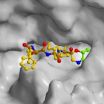(Press-News.org) What makes cancer cells so dangerous is that they grow in an unregulated way and proliferate much faster than other cells. The proteasome, a large protein complex, plays a key role in this process: By breaking down used proteins for recycling, it clears the way for the next cycle. New hope was spawned several years ago with the discovery that inhibiting proteasomes can be used as a means to put the brakes on cell growth. In the mean time, the first drug using this approach, Bortezomib, generates revenues in excess of one billion U.S. dollars per year. However, it also inhibits other important proteins and thus sets off a host of severe side effects. Hence, there is a worldwide search for alternatives.
A variant of the proteasome, the immuno-proteasome, is a leading actor in another vital process: the immune reaction. The production of human insulin in genetically modified bacteria is a boon for diabetes patients. But calculating required doses and injecting insulin on a daily basis is a considerable burden. The transplantation of intact insulin-producing islet cells from pigs could be a solution, but the immune reaction stands in the way. If physicians were able to curb the immuno-proteasome temporarily, they could possibly get the rejection reaction under control.
In both cases, targeting the intervention as specifically as possible is essential to minimizing the damage caused by side effects. Besides Bortezomib two other proteasome inhibitors – Carfilzomib and Salinosporamide A, derived from a poison produced by a marine bacterium – are already in the human clinical trial stage. In earlier research, Professor Groll's team succeeded in explaining the mechanism of action of both substances. They follow the same principle, which is considerably more specific than Bortezomib in binding at the desired location in the proteasome and thus produce significantly fewer side effects. Yet, when they take effect, they destroy the proteasomes irreversibly. While healthy cells survive by building up a new proteasome, the fast-growing cancer cells suffocate in their own waste and end up in apoptosis.
The trick of both of these proteasome blockers is a two-step reaction. The tiny molecule fits a specific site on the proteasome like a key going into a lock. However, the reversible docking at the binding site is followed by an irreversible ring formation that prevents the key from being pulled back out. By choosing another head group, Professor Michael Groll und Dr. Melissa Graewert were able to achieve a reversible ring formation. The new head group contains an aldehyde and a keto group in immediate proximity. They also react with the binding sites on the proteasome by forming a ring. However, the reaction of these two groups is reversible: The key can be removed from the lock and the proteasome can resume its work.
Within the framework of their work supported by the Cluster of Excellence Center for Integrated Protein Science Munich (CIPSM), the TUM scientists succeeded in confirming the assumed mechanism using X-ray structure analysis of inhibited proteasome crystals. It also became clear how this binding mechanism could be developed into a drug with fewer side effects. In addition to the head group, the binding mechanism contains a short chain of amino acids that can be designed to fit into the binding pockets of the proteasome. By varying the amino acids, the binding can be optimized to specifically attack immuno-proteasomes.
"The reversible two-step binding mechanism shown here is unique to proteasomes," says Michael Groll, who holds the Chair of Biochemistry at the Department of Chemistry of the Technische Universitaet München. "This explains the high selectivity and leads us to expect relatively minor side effects. The reversible reaction opens up a much wider field of application. We can now develop these binding mechanisms further in the direction of immunosuppressive agents." It is precisely this challenge the researchers are now taking on, in close collaboration with physicians, through a new SFB-transregional initiative: "Biology of xenogenic cell and organ transplantation – from bench to bedside."
INFORMATION:
This research was funded with grants from the Deutsche Forschungsgemeinschaft (DFG, Cluster of Excellence Center for Integrated Protein Science Munich, CIPSM, and SFB 595) and the Traudl and Peter Engelhorn Foundation (to Melissa Graewert). The X-ray crystallography experiments were performed at the PXI beamline of the Swiss Light Source, Paul Scherrer Institut, Villigen, Switzerland.
A new mechanism for reversible proteasome inhibition
Fighting cancer and steering immune reactions
2010-12-14
ELSE PRESS RELEASES FROM THIS DATE:
A study analyzes the movement of tree sap
2010-12-14
The researchers decided to embark on this study in order to find out which mechanisms are used by plants when they extract water from very dry or somewhat inhospitable land. "In the case of mangrove swamps, for example, the plants are able to extract freshwater from a saltwater environment, despite the fact that the osmotic pressure should make quite the opposite happen", explains Professor José Luis Pérez Díaz, who studies this type of relatively unknown phenomenon as part of a new line of research that the Department of Mechanical Engineering at UC3M has begun.
The ...
Choose a movie's plot -- while you watch it
2010-12-14
Tel Aviv ― Will Rona and Sol kiss and seal their fate as a couple forever, or will Sol answer the ringing phone and change the course of history? A new movie format developed by Tel Aviv University lets the viewer decide.
Utilizing complicated video coding procedures, the new format provides smooth interaction and transition between scenes as audience members watch ― and determine the plot of ― Turbulence, created by Prof. Nitzan Ben Shaul of Tel Aviv University's Department of Film and Television. Made with his unique scene-sequencing technique, Turbulence ...
Earthshaking possibilities may limit underground storage of carbon dioxide
2010-12-14
Storing massive amounts of carbon dioxide underground in an effort to combat global warming may not be easy to do because of the potential for triggering small- to moderate-sized earthquakes, according to Stanford geophysicist Mark Zoback.
While those earthquakes are unlikely to be big enough to hurt people or property, they could still cause serious problems for the reservoirs containing the gas.
"It is not the shaking an earthquake causes at the surface that creates the hazard in this instance, it is what it does at depth," Zoback said. "It may not take a very big ...
Britain at political crossroads
2010-12-14
The National Centre for Social Research today released its latest British Social Attitudes report, its landmark study of the public's attitudes and values, published annually for almost thirty years.
This year's report delivers the public's verdict after thirteen years of Labour rule. It shows a nation at a political crossroads. On the one hand attitudes on welfare have hardened to the right. On the other, many think there were marked improvements in health and education under Labour, creating potential resistance to reform or cuts in these areas.
A shift to the right ...
R-E-S-P-E-C-T: The health of health care depends on it
2010-12-14
INDIANAPOLIS – Along with integrity and compassion, respect for patients, colleagues and other team members is an essential attribute of medical professionalism. A new study examines how medical students learn respectful or disrespectful professional behavior.
"Exploring the Meaning of Respect in Medical Student Education: An Analysis of Student Narratives" appears in the December 2010 issue of the Journal of General Internal Medicine. From the observations and conclusions of third-year medical students, the article provides insight into how future physicians acquire ...
Guidance on preventing unintentional injuries to children
2010-12-14
Researchers from the Peninsula Technology Assessment Group (PenTAG) at the Peninsula College of Medicine and Dentistry have contributed to new National Institute for Health and Clinical Excellence (NICE) guidance on preventing unintentional injury to the under-15s.
The public health guidance is based on reviews of research evidence produced by the team at PenTAG. There are three linked pieces of guidance on: home safety assessments and safety equipment; road design and modification; and broader strategies to prevent unintentional injuries to among children and young people ...
Rice researchers take molecule's temperature
2010-12-14
You can touch a functioning light bulb and know right away that it's hot. Ouch! But you can't touch a single molecule and get the same feedback.
Rice University researchers say they have the next best thing -- a way to determine the temperature of a molecule or flowing electrons by using Raman spectroscopy combined with an optical antenna.
A new paper from the lab of Douglas Natelson, a Rice professor of physics and astronomy, details a technique that measures the temperature of molecules set between two gold nanowires and heated either by current applied to the wires ...
Tracking down particulates
2010-12-14
For some years now, consumers have been making increasing use of wood as a fuel – and not only on account of the rising cost of heating oil and natural gas. "Comfort fireplaces" have become all the rage because open fires, tiled and wood-burning stoves give a room a snug and cozy feel. But using wood for heating has one distinct disadvantage. When pellets, logs or briquettes are burnt, fine dust particles that are hazardous to health are released into the atmosphere. These particles are known to cause coughs, place stress on the cardiovascular system, and are thought to ...
'Array of arrays' coaxing secrets from unfelt seismic tremor events
2010-12-14
Every 15 months or so, an unfelt earthquake occurs in western Washington and travels northward to Canada's Vancouver Island. The episode typically releases as much energy as a magnitude 6.5 earthquake, but it does so gradually over a month.
New technology is letting University of Washington researchers get a much better picture of how these episodic tremor events relate to potentially catastrophic earthquakes, perhaps as powerful as magnitude 9, that occur every 300 to 500 years in the Cascadia subduction zone in western Washington, Oregon and British Columbia.
"Depending ...
Less than they are worth
2010-12-14
Carsten Beier from the Fraunhofer Institute for Environmental, Safety and Energy Technology UMSICHT in Oberhausen, Germany does not believe that "anyone would burn a 50-dollar bill just to keep warm. It's obvious that it simply is too valuable for that." But, in contrast to dollar bills, most energy carriers are all too frequently burned for less than they are worth. Take wood, for example. Beier and his colleagues have analyzed the efficiency of heat supply systems and he explains that "wood is a high-quality fuel that can be compared to natural gas. With adequate technologies ...
LAST 30 PRESS RELEASES:
Interaction of climate change and human activity and its impact on plant diversity in Qinghai-Tibet plateau
From addressing uncertainty to national strategy: an interpretation of Professor Lim Siong Guan’s views
Clinical trials on AI language model use in digestive healthcare
Scientists improve robotic visual–inertial trajectory localization accuracy using cross-modal interaction and selection techniques
Correlation between cancer cachexia and immune-related adverse events in HCC
Human adipose tissue: a new source for functional organoids
Metro lines double as freight highways during off-peak hours, Beijing study shows
Biomedical functions and applications of nanomaterials in tumor diagnosis and treatment: perspectives from ophthalmic oncology
3D imaging unveils how passivation improves perovskite solar cell performance
Enriching framework Al sites in 8-membered rings of Cu-SSZ-39 zeolite to enhance low-temperature ammonia selective catalytic reduction performance
AI-powered RNA drug development: a new frontier in therapeutics
Decoupling the HOR enhancement on PtRu: Dynamically matching interfacial water to reaction coordinates
Sulfur isn’t poisonous when it synergistically acts with phosphine in olefins hydroformylation
URI researchers uncover molecular mechanisms behind speciation in corals
Chitin based carbon aerogel offers a cleaner way to store thermal energy
Tracing hidden sources of nitrate pollution in rapidly changing rural urban landscapes
Viruses on plastic pollution may quietly accelerate the spread of antibiotic resistance
Three UH Rainbow Babies & Children’s faculty elected to prestigious American Pediatric Society
Tunnel resilience models unveiled to aid post-earthquake recovery
Satellite communication systems: the future of 5G/6G connectivity
Space computing power networks: a new frontier for satellite technologies
Experiments advance potential of protein that makes hydrogen sulfide as a therapeutic target for Alzheimer’s disease
Examining private equity’s role in fertility care
Current Molecular Pharmacology achieves a landmark: real-time CiteScore advances to 7.2
Skeletal muscle epigenetic clocks developed using postmortem tissue from an Asian population
Estimating unemployment rates with social media data
Climate policies can backfire by eroding “green” values, study finds
Too much screen time too soon? A*STAR study links infant screen exposure to brain changes and teen anxiety
Global psychiatry mourns Professor Dan Stein, visionary who transformed mental health science across Africa and beyond
KIST develops eco-friendly palladium recovery technology to safeguard resource security
[Press-News.org] A new mechanism for reversible proteasome inhibitionFighting cancer and steering immune reactions




